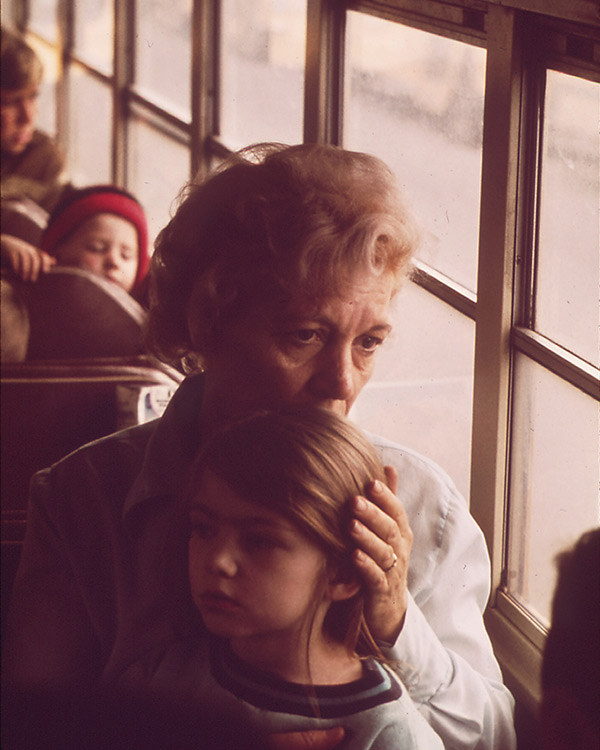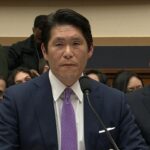
Published May 12, 2023
While flying home from the Midwest a month ago, I was paying more attention to the boarding process than I usually do. I had a tight connection to make, and boarding had been delayed by the Delta agent’s demand that a predetermined number of carry-on bags be checked before he’d open the gate door. For more than twenty minutes, he counted down dramatically as one passenger then another came forward to reluctantly relinquish his bag. Finally, the last piece of luggage was dropped at the agent’s feet, and I and a whole host of other passengers erupted in enthusiastic cheers. But what happened next is what has stayed with me since: as the agent called for both active-duty military personnel and families with small children to board, and a few of the latter ambled sweetly by, I noticed that I was actively suppressing the desire to keep cheering. Of course these two groups had been given priority boarding together on many of my prior flights, but in that moment, I rejoiced that the airline had gotten at least this just right.
Historically, in many important public policy debates in our country, mothers were explicitly and favorably compared to soldiers and war veterans. Like soldiers, mothers were understood to serve the common good in a uniquely sacrificial way. Speaking to the Congress of Mothers in 1908 at their First International Congress for the Welfare of the Child, President Theodore Roosevelt declared: “This is the one body that I put even ahead of the veterans of the Civil War; because when all is said and done it is the mother, and the mother only, who is a better citizen even than the soldier who fights for his country … the mother is the one supreme asset of national life.” Unlike today, this early twentieth-century maternalist rhetoric was culturally ubiquitous and matched by material support.
Scores of young people in our day are declaring their intention not to have children. The demographic winter that has frozen fertility rates in other Western countries has arrived at US shores. The reasons for the ambivalence around (or outright dismissal of) starting a family are both cultural and economic, even as the material and emotional demands of having children soar. Veterans today are justly provided disability compensation, pensions, education, training and employment services, health care, home loans, insurance, and even burial costs. Mothers (and fathers), whose caregiving labors make possible all other goods, are barely given thanks. It’s time to resurrect the soldier-mother analogy and provide caregiving parents their just due.
Protecting Soldiers and Mothers
Thirty years ago, Harvard sociologist Theda Skocpol wrote the award-winning book, Protecting Soldiers and Mothers: The Political Origins of Social Policy in the United States. In it, she masterfully explores the fascinating historical fact that though Civil War veterans (or their surviving dependents) were the very first Americans to receive direct federal benefits, it was widows and abandoned mothers – rather than, as in other Western countries, disabled or aging male workers – who next received direct assistance, and on similar grounds. Pensions for veterans and then mothers were recognized as a matter of justice, not as a concession to charity.
During the mid-nineteenth century, European parliaments, at the behest of strong labor parties with corporatist philosophies, had begun creating “paternalist” workers’ insurance and pension programs for the express benefit of “respectable elderly of diminished means.” By contrast, means-tested relief for breadwinners who had fallen on hard times or old age was not part of pre-New Deal social policy in the United States. According to Skocpol, the “precocious social security system” simultaneously created in the United States was justified on moral terms, not socioeconomic ones. Civil War military pensions – which could eventually be collected as lump sums in arrears and for service rather than only injury or financial need – were “justly due to the righteous core of a generation of men (and survivors of dead men) – a group that ought to be generously and constantly repaid by the nation for their sacrifices.” Categorized as military costs, the pensions were honorably received.
With the success of the program, and as more European parliaments created compulsory social insurance programs, elite intellectuals and reformers across the Atlantic hoped the military pensions would serve as an entering wedge in favor of old-age insurance for breadwinners. Leading reformer University of Chicago sociologist Charles Richmond Henderson smartly employed moral analogies between veterans and workers, writing in 1909: “The nation and the states have already declared it to be our duty to shelter the aged and wounded soldier, why should the victims of the ‘army of labor’ be neglected?” Henderson’s argument was likewise one based in justice, not mere socioeconomic need, maintaining that the “the modern conception of the state owes certain duties toward those who are in an economic position of dependence.” Henry Rogers Seager, Henderson’s most prominent student and fellow social reformer, expressly conceived of government as “an organized machinery for advancing our common interests,” arguing that “the simple creed of individualism is no longer adequate.” He said, “we need not freedom from governmental interference, but clear appreciation of the conditions that make for the common welfare.” It was their position that even the hard-working and thrifty man could not earn enough in the new industrial setting to put aside some savings for an unexpected accident, illness, or economic crisis. The new capitalist industrial system depended for its own efficiency and growth on labor; thus, society owed workers and their dependents assistance in the face of such contingencies. Yet, until the New Deal two and a half decades later, the only law passed at the male reformers’ behest was employer-provided compensation for industrial accidents.
Skocpol’s historical account provides lessons for today not primarily because it explores why these leading intellectual lights failed where many European countries succeeded, though it does that with keen insight. Anyone familiar with the Lochner Era in US constitutional history knows how aggressively courts struck down – on the basis of Fourteenth Amendment contractual “liberty” and “property” rights – laws that sought to regulate industrial workplaces and asymmetrical bargaining relationships between capital and labor. (By 1920, three hundred labor laws were ruled unconstitutional.) As a result, the reformers were unable to convince organized labor to lobby on behalf of social insurance, as union bosses preferred to take their chances in private negotiation with employers. “You can’t pass an eight-hour day without changing the Constitution,” one of them put it; “I am opposed to wasting our time.” And the unions did not hold back their disdain for the elite reformers (who hailed from the same social class as the judges): “the people who present [government programs] represent a class of society that is very desirous of doing things for the workers and establishing institutions for them that will prevent their doing things for themselves and maintaining their own institutions.” As one delegate put it at the 1914 American Federal of Labor (AFL) convention: “Working people do not want charity from the government – they want justice.” Polling from the Institute for Family Studies reveals a similar theme today: direct cash to individuals or families without work requirements is viewed far more skeptically by potential working-class recipients than by the would-be reformers of the laptop class.
But while the reforming academics of the late nineteenth and early twentieth centuries failed to persuade other masculine spheres of influence – unions, corporations, and politicians – of their paternalist plans, federations of mothers working hand-in-hand with maternalist female professionals prevailed upon the very same groups in favor of governmental support and protection of mothers. At the turn of the century, the Women’s Christian Temperance Union, directed by the indefatigable Frances Willard, numbered 168,000 dues-paying members in approximately seven thousand locals from every state in the union. (Notably for the time, WCTU locals included not only middle-class white women but black and Native American women too.) But WCTU was only the largest among the federations of socially organized, politically mobilized women’s groups; there were many others, and they were incredibly influential.
The Rise of the Maternalists
As a result of maternalist mobilization at the grassroots level (local power the male intellectuals lacked), forty states between 1911 and 1920 and four more before the early 1930s passed legislation enabling localities to provide pensions to widows (and sometimes other needy mothers); states passed – and the Lochner court would come finally to allow – key workplace protections for women that were not allowed for men; in 1912, the federal government established the Children’s Bureau “run solely by women … without parallel elsewhere in the world”; and incredibly, in 1921, Congress passed the Sheppard-Towner Infancy and Maternity Protection Act, allocating federal funds for thousands of pre- and post-natal clinics to reduce exceedingly high rates of infant and maternal mortality in the United States. In lobbying for the last, the League of Women Voters articulated the full maternalist view: “Prenatal and maternity care means more than good obstetrics; its means normal family life, freedom of the mother from industrial labor before and after childbirth, ability to nurse the child, above all, education the standards of care so that women and their husbands will demand good obstetrics and will no longer run the risk of … preventable tragedies.”
Skocpol writes: “When liberal values of individualism, self-sufficiency, voluntarism, distrust of government, and market competition were supposedly at their height in the late nineteenth century, Americans countenanced such widespread and relatively generous benefits, delivered directly by the federal government.” Why? Because women made compelling arguments from within the Christian, republican, and commonwealth traditions, offering, Skocpol suggests, “alternative sources of legitimation for public social provision.” In a word, before women had any direct access to political power, hundreds of thousands of them through local church and community groups, state and nationwide federations, settlement homes, and women’s magazines persuaded a nation that ensuring stable economic conditions for the work of nurture, care, and character-formation in the home was a matter not of charity but of justice.
American women in the late nineteenth century were the most highly educated women in the world, the United States having established common schools in rural areas much earlier than other nations. Colleges also had opened their doors to women at a faster pace. The socially engaged middle class mothers who were calling for social, moral, and legal reforms – “social housekeeping” – were generally college-educated and had often worked before beginning their families. Expressly connecting illiteracy, child labor, prostitution, divorce, and abortion and infanticide to subpar economic conditions, these middle-class women fought for their working class and poor sisters, establishing settlement houses for single mothers, nurseries for working women, and demanding protection and provision for their families from the state.
The good of motherhood was valued universally – across races and classes – with the National Congress of Mothers founded in 1897 “to carry out mother-love and mother-thought into all that concerns or touches childhood in Home, School, Church, State or Legislation.” The Congress was founded by Alice McLellan Birney, the wife of a DC lawyer who witnessed in the nation’s capital lobbying groups of all kinds, but none dedicated to the good of children and their mothers. Birney said in a public address: “Nature has set her seal upon woman as the caretaker of the child; therefore it is natural that woman should lead in awakening mankind to a sense of the responsibilities resting upon the race to provide each newborn soul with an environment which will foster its highest development.”
The influential professional women of the time who led the social settlement movement – Jane Addams, Florence Kelley, Julia Lathrop – offered no exception: they too saw the work they did knitting together social classes as a deeply maternal one, even referring to themselves as “public mothers.” Suffragist Rheta Childe Dorr well summarized in 1910 the maternalist spirit of the age: “Woman’s place is in the Home. … But Home is not contained within the four walls of an individual home. Home is the community. The city full of people is the Family. The public school is the real Nursery. And badly do the Home and the Family and Nursery need their mother.”
Justice Owed
The arguments these women made on behalf of mothers’ pensions, child and maternal health programs, and labor reforms were more often than not arguments from justice. Recounting stories of children put in orphanages “only because, through no fault of their own, [their mothers] are poor,” they argued that children deserved to be with their mothers and mothers with their children. The soldier analogy was readily employed: “The woman who produces citizens and soldiers should be placed in a class with the disabled soldier, during the period she is unable to earn for herself and children,” said Mary Wood at a national gathering of the General Federation of Women’s Clubs. In 1911, at the Second International Congress on Child Welfare, the President of the Tennessee Congress of Mothers, said: “We cannot afford to let a mother, one who has divided her body by creating other lives for the good of the state … be classed as a pauper, a dependent. She must be given value received by her nation and stand as one honored. … If she has given a citizen to the nation, then the nation owes something to her.” The Congress’s official journal, in one of dozens of advocacy article on mothers’ pensions, published one that read: “This recognition of motherhood is not charity. It is justice to childhood[,] economy to the state, and given for service rendered just as the soldier service is recognized.”
Skocpol and others suggest that ultimately (modest) mothers’ pensions and the Sheppard-Towner Act prevailed in the early twentieth century because otherwise skeptical legislators in Congress feared that women, who already seemed to wield such influence at the grassroots, would vote as a single bloc when they won the right to do so in 1920. Once the Nineteenth Amendment was ratified and the threat seemed less likely – and both the American Medical Association and charitable organizations reasserted their opposition to the programs – both programs fizzled, leaving vulnerable families less economically secure on the eve of the Great Depression. The New Deal eventually intervened, with influences both maternalist and paternalist: FDR’s legislation secured the labor regulations for which the male-dominated unions and female labor advocates like Florence Kelley had both worked; old-age social security provisions the male reformers had sought; benefits for poor children; and by amendment five years later, for widows too.
In 1924, the National Congress of Mothers became the National Parent-Teacher Association, turning its attention to public education. But a century later, mothers (and fathers) are still struggling. No lobbying association of moms and dads – as parents – exists today, inspiring author of Parent Nation, Dana Suskind, to pen an Atlantic essay entitled: “Parents Need Their Own AARP.”
Today, the United States has the highest rate of female-headed households in the world, as well as very high rates of maternal and infant mortality. As Maxine Eichner writes in her recent data-rich book, The Free-Market Family, most of the economic gains that middle-class households have made over the last half century are due to increased income from working mothers, gains that sole earners – especially single mothers – do not enjoy. Meanwhile, those two-earner families “put in twice as many hours of paid work than couples did two generations ago,” more combined time away from their families than couples in any other wealthy country. It’s no wonder, Eichner observes, that the United States is the third most depressed nation in the world.
American parents need not only opportunities for justly remunerated work, as that nineteenth-century union boss declared; they also need pro-family policies that, as Eichner rightly argues, “insulate family life from market pressures” so that parents have time to provide the nurture and care that only they can do. Reviewing the panoply of veterans’ benefits for their transferability as caregiver benefits would be a good place to start.
Economists and social scientists disagree sharply about the precise causes and contours of the ills facing families today. Suffice it say, the sexual and technological revolutions of the last half century have been just as, if not more, destabilizing than the industrial revolution to which nineteenth-century maternalism responded so successfully. Though paeans to “mother-love” and “mother-thought” are unlikely to provide the compelling political narrative needed to mobilize the grassroots today, renewing national honor and material support of mothers and fathers – in much the same way we honor and support our veterans and for the same reasons – must become a top priority. As the women and men who provide the very preconditions for every other social, economic, and political good – and often at great personal sacrifice to themselves – it’s their just due. As in the mid-nineteenth century, dedicated mothers (and now fathers too) ought to be “given value received and stand as one honored,” for the nation “owes” them, at the very least, our gratitude – and more still.
EPPC Fellow Erika Bachiochi is a legal scholar specializing in Equal Protection jurisprudence, feminist legal theory, Catholic social teaching, and sexual ethics. She is also a Senior Fellow at the Abigail Adams Institute in Cambridge, MA, where she founded and directs the Wollstonecraft Project. Her newest book, The Rights of Women: Reclaiming a Lost Vision, was published by Notre Dame University Press in 2021.









